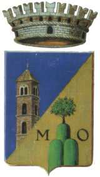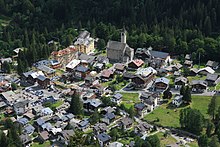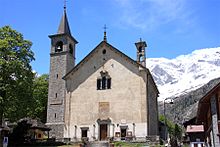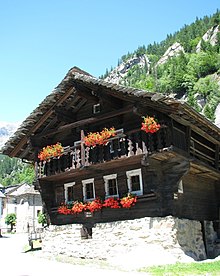Macugnaga
| Macugnaga | ||
|---|---|---|

|
|
|
| Country | Italy | |
| region | Piedmont | |
| province | Verbano-Cusio-Ossola (VB) | |
| Coordinates | 45 ° 58 ′ N , 7 ° 58 ′ E | |
| height | 1327 m slm | |
| surface | 98 km² | |
| Residents | 537 (Dec. 31, 2019) | |
| Population density | 5 inhabitants / km² | |
| Post Code | 28876 | |
| prefix | 0324 | |
| ISTAT number | 103039 | |
| Popular name | macugnaghesi | |
| Patron saint | Assumption of Mary ( August 15 ) | |
| Website | Macugnaga | |
 Macugnaga, fraction Pecetto (zer Tannu) |
||
Macugnaga ( Walser German Magganaa ) is an Italian commune in the province of Verbano-Cusio-Ossola (VB), Piedmont region . She is the holder of the Bandiera Arancione of the TCI .
geography
The highest district, Pecetto, is 1327 m above sea level. M. , the lowest, Pestarena, is 1075 m above sea level. M. Macugnaga lies at the end of the Valle Anzasca (Walser German Vischpertal ) in a classic glacial trough valley , which was formed by the mighty glaciers of the Monte Rosa massif and its northern foothills and is dominated by huge moraines in the upper part.
The municipality covers an area of 98 km², with a maximum sea level of 4.618 m above sea level. M. ( Monte Rosa , border summit next to the Dufourspitze in Switzerland at 4.634 m above sea level ). The Margheritahütte , the highest building in Europe, is located in the municipality. The neighboring municipalities are Alagna Valsesia , Alto Sermenza , Carcoforo and Ceppo Morelli .
The community consists u. a. from the districts (Walser German Pestarena In Mattu ) Borca (Walser German cerium Burfuggu ), Headline (Walser German Uf the Biil ) Staffa (Walser German In d Schtapfu ), Chiesa Vecchia (Walser German cerium altu Chilchu or Duorf ) Opaco (Walser German In d Ääbi ), Ripa (Walser German Uf d Riifu ) and Pecetto (Walser German Zer Tannu ). There are a total of 19 parliamentary groups, four of which are divided into two more.
The main occupation of the population today is tourism.
History and language
Macugnaga is an old Walser settlement that was settled in the 12th century from the Swiss Saas Valley ( Valais ) and has retained its centuries-old, independent cultural stability into the 20th century. Pestarena is first documented in 1291 (Peza Saltaneria), Motta in 1361, Pecetto in 1373 and Borca in 1458.
Franz Josef Lochmatter from St. Niklaus in Valais opened the first hotel in Macugnaga in 1854 and called it «Monte Rosa». This was the birth of tourism in Macugnaga. Another hotel followed by Domenico Oberto's Monte Moro.
From the 19th century as a result of mining in the lower municipal area and in the 20th century as a result of fascism, tourism and the modern networked lifestyle, the municipality was largely Italianized linguistically. The local dialect called Titschu , a variant of the highest Alemannic Walser German , is dying out with the generation of over eighty-year-olds. Enduring witnesses of Walserism are numerous architectural monuments in the log house style , which are, however, beset by modern, not always sensitively integrated hotel buildings in all districts.
The dialect is documented in the Linguistic Atlas of German-speaking Switzerland , in the Swiss Idiotikon and in Max Weibel's Die Volksstümliche Tradition in the Walser Colony Macugnaga (Novara Province), Basel 1985 (Writings of the Swiss Society for Folklore, Volume 70).
population
| Population development | |||||||||||||||
|---|---|---|---|---|---|---|---|---|---|---|---|---|---|---|---|
| year | 1861 | 1871 | 1881 | 1901 | 1921 | 1931 | 1951 | 1971 | 1991 | 2001 | 2011 | 2018 | |||
| Residents | 664 | 603 | 617 | 798 | 610 | 640 | 997 | 766 | 626 | 651 | 601 | 554 | |||
Attractions
- Old church Maria Assunta in the district of Duorf, first mentioned in 1317, renovated and re-consecrated in 1523.
- Parish church of Madonna Assunta in the Staffa district, built between 1709 and 1717, with a polychronic choir and two paintings by the painter Bartolomeo Iacchini. A plaque commemorates the ascent to the Dufourspitze of the priest Achille Ratti and later Pope Pius XI.
- Church of San Giovanni Battista from the 17th century, expanded and remodeled in 1684 and equipped with a cemetery in 1789, which is used for all the hamlets in the valley.
- Beata Vergine delle Nevi (Ad Nives) church in the Borca district, built in 1653, with a number of remarkable frescoes inside.
- Local history museum (Museo Casa Walser Alts Walserhüüs van zer Borfuggu): In the rectory, which dates from the 17th century, more than 650 objects can be viewed, which tell of the everyday life of the Walser population at home and at work.
- Mountain Museum: exhibition of objects from the past of mountain climbing around Macugnaga. The history of mountain guides and smugglers is dealt with in two sections.
- Casa Pala in the district of Pecetto: Typical example of Walser architecture, national monument. The building dates from the end of the 16th century and is divided vertically into two parts.
- Guia gold mine in the Borca district can be visited.
- Church of Madonna dei Ghiacciai in the Pecetto district, built in 1635 according to an inscription.
- Old linden tree (vecchio tiglio) in the district of Chiesa Vecchia, in whose shade the community meetings, the annual market and the court hearings were held. The linden tree, declared a national monument, dates from the 13th century and is seven meters in circumference.
Personalities
- Anton de Augustini (born August 4, 1743 in Macugnaga; † June 18, 1823 in Leuk ), lawyer and notary, bailiff of Monthey , member of the provisional directorate of the Valais , co-author of the Valais criminal and civil code, member of the Helvetic directorate
- Franz Josef Lochmatter (1825–1897), Macugnaga's tourism pioneer
literature
- Various authors: Comuni della Provincia del Verbano-Cusio-Ossola. Consiglio Regionale del Piemonte, Chieri 2012, ISBN 978-88-96074-50-3 .
- Various authors: Il Piemonte paese per paese. Bonechi Editore, Firenze 1996, ISBN 88-8029-156-4 .
- Max Weibel: The popular tradition in the Walser colony Macugnaga (Province of Novara) (= writings of the Swiss Society for Folklore. Volume 70). Basel / Bonn 1985, ISBN 3-7749-2189-X .
Web links
- Homepage of the community
- Macugnaga (Italian) on tuttitalia.it
- Macugnaga (Italian) on comuni-italiani.it
- Macugnaga (Italian) on piemonte.indettaglio.it/ita/comuni
- Public transport timetable of the Verbano-Cusio-Ossola Province (Italian)
- Macugnaga on the ETHorama platform
- Pizzo Bianco on ETHorama
Individual evidence
- ↑ Statistiche demografiche ISTAT. Monthly population statistics of the Istituto Nazionale di Statistica , as of December 31 of 2019.
- ↑ Bandiera Arancione. In: Bandierearancioni.it. Retrieved May 7, 2018 (Italian).
- ↑ Max Weibel: The popular tradition in the Walser colony Macugnaga (province of Novara) (= writings of the Swiss Society for Folklore. Volume 70). Basel / Bonn 1985, p. 2.
- ↑ Christian Imboden: Mountains: Profession, Vocation, Fate . Rotten Verlag, Visp 2013, ISBN 3-907624-48-3 , p. 75: innkeepers .
- ^ Frédéric Giroud: Anton de Augustini. In: Historical Lexicon of Switzerland . February 18, 2010 , accessed April 27, 2020 .







